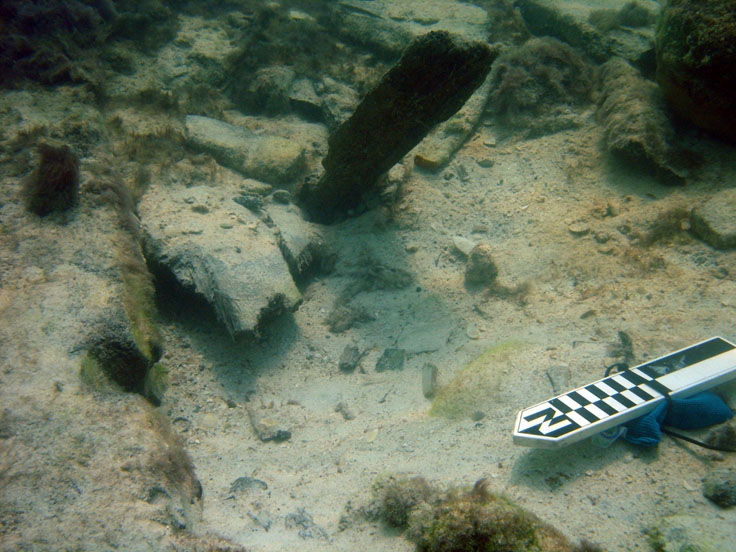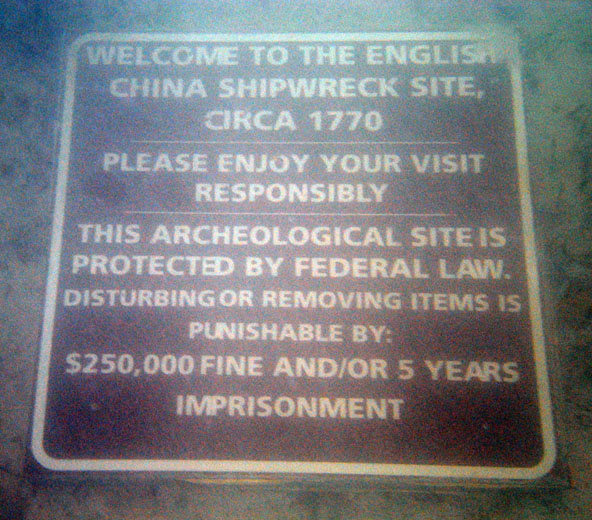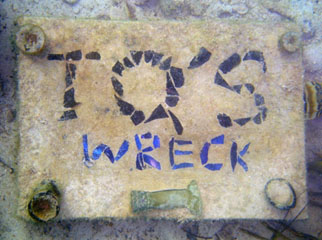
Looters damage wrecks on Biscayne floor
Editor’s note: Click here to read our writer’s blog post about her use of social media in the preparation of this story.
HOMESTEAD, Fla. – Centuries ago, many Spanish ships passed through Florida’s harsh and shallow waters delivering gold, copper, silver and other cargo. But not all of them made it to their final destinations.
Many of the ships ended up sinking because of bad weather conditions and the dangerous currents.
And approximately 252 years later, the ships have remained intact, but not as some would have hoped.
Why? One word: Looters.
| This is what a Biscayne National Park shipwreck site looks like after looters have attempted to find souvenirs or valuable items to take home. The marker points to the broken and pried up ship timber that was left after being vandalized by divers (Photos courtesy of Charles Lawson, National Park Service). |  |
Divers and visitors that have found their way down to the wrecks have decided to take pieces of what was left. And, if they don’t find what they want, they begin digging deeper – and still find nothing.
This used to be legal, until Florida passed the Archeological Resources Protection Act, (ARPA), which bans any stealing or vandalizing from these historical memorials in 1979.
Most, if not all, of the sites have signs reminding individuals that it is prohibited to take anything from the area, but some pretend not to see the sign sand others just don’t care.
Charles Lawson, an archeologist and Cultural Resource manager for Biscayne National Park, said that looting is still taking place, but it is nowhere near as significant as it used to be in previous years.
“It used to be that people put together crews and they would go out there and put down three anchors and stay still and go to town on a shipwreck, but that doesn’t happen anymore,” Lawson said. “Now, we would notice that.”
Law enforcement is now in place to deal with these criminals. But, Lawson said, it is all about “being there at the right place and at the right time.”
If not, there is a chance that divers could still get away with it, but it is quite a difficult task.
“There are only four rangers in the whole park, but if they are [out on the water] they will catch them,” Lawson said. “And everyone out on the park in boats is watching as well. It is by eyeballs and staff.”
Biscayne National Park houses more than 75 submerged archeological sites – 45 of them are preserved shipwrecks while the rest are isolated individual artifacts and stranding sites.
Allison Goodman, a certified scuba diver for nearly three years, enjoys the experience of shipwreck diving and does not advocate looting.
“Diving in a wreck is a magical experience with marine life teeming around every corner,” Goodman said. “It’s like swimming back in time. I would never think to take anything from a wreck, especially because it would ruin the experience for others.”
 |
The sign that appears in front of the English China site, also known as Circa 1770. At all shipwreck and submerged archeological sites, divers will see this type of sign that reminds them that looting and vandalizing the sites is illegal and punishable by law. Anyone caught can receive up to five years in jail and/or a fine up to $250,000. |
This is the mindset Lawson wishes everyone would have.
Archeologists work to preserve history. And the wrecks hold a lot of artifacts that have no monetary value, but plenty of cultural and educational value. Because of this, archeologists’ goal is to make sure sites like the shipwrecks last forever – free from vandalizing and looters.
Carrie Caignet, a historian for Florida Maritime, said that some of the shipwrecks in Biscayne National Park’s marine sanctuary date back to the 1600s and that many of the Spanish would try to salvage items after the ship sank.
“Looting and salvaging was big during this time,” Caignet said. “A lot of the Spanish tried to salvage things but they couldn’t recover everything. When diving equipment began to come around, they would salvage gold and silver not necessarily for the people, but for personal gain.
Unfortunately, there is still one shipwreck site that must constantly be monitored – the English China wreck, also known as Circa 1770. According to Lawson, there are approximately 4,500 broken plates at the site and none of them are intact.
But, visitors and divers don’t know this.
Therefore, they dig until they can’t dig anymore and rip off coral heads in an attempt to find plates that are intact – with no success. Little by little, the china wreck becomes more and more devastated because of this.
According to Lawson, many divers visit the English China wreck because it is a great place to find lobster. But, it is a sensitive site to swim around because of this.
“Most people know where it is, but I am not telling anyone where it is because it sees enough damage as it is,” Lawson said. “Personally I wish people didn’t lobster there, but they can. And they can visit.”
If sites continue to be looted, future generations will have nothing left to discover underwater. And archeologists will have no artifacts to evaluate and study. Ultimately, a piece of our American history will be lost in the hands of people and the world beneath us – under the sea.
“If there is something with some relative significance, people just want to take it,” Caignet said. “They have this idea that it is a Disney World of sorts and people intrinsically feel they have this entitlement.”
Joe Bailey, who asked that his name be changed for the article, is guilty of looting at shipwreck sites, including the English China wreck. He said he didn’t know about the federal laws in place at the time.
“I wanted a souvenir to take back home and it couldn’t be heavy,” Bailey said. “I took some pieces of plates because I thought it was cool. I kind of thought finders keepers, loser weepers.”
| This is the sign found at TQ’s Wreck, one of the many shipwreck sites found in the park. Signs are placed so that divers can identify each site by name and know where they are. If divers are using a map to locate the sites, a sign at the site confirms that they are at the right place. |  |
Bailey has also dug around wrecks looking for “treasure.” But, he hasn’t in the last two years since he realized that it was wrong. He’s been a certified scuba diver for nearly six years.
“Would I do it again? No,” Bailey said. “I understand the consequences now, but most of all, I understand the importance of keeping them as intact as possible. They’re memorials.”
Lawson says “souvenir hunting” is becoming more popular because divers see something and they become “enticed to look for more.” But, his mission to protect these timeless treasures remains the forefront of his job as an archeologist.
He said it is “basic archeological ethics of the modern era.”
“Most of the sites have been looted to death and there isn’t really a whole lot of artifacts left on any of them, really, but there’s a couple of sites in the park that weren’t looted,” Lawson said. “Those are the ones that I am most concerned with.”
If You Go
- For more information visit http://www.nps.gov/bisc/index.htm
- Address: 9700 SW 328 St., Homestead, Fla. 33033.
- Hours: Mondays through Sundays 7 a.m. to 5:30 p.m.
- For underwater services, visit http://www.BiscayneUnderWater.com
- The underwater portion of the park is open 24 hours a day, but access is only available by boat.
- Snorkeling, diving, boating, fishing, picnicking, glass bottom boat rides and canoes are available.
- Phone: 305-230-7275.

Comments are Closed